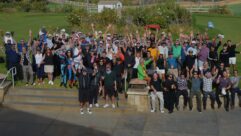
Medieval Times Dinner & Tournament
Dec 1, 2001 12:00 PM,
By Mel Lambert
The turn of the last millenium is a time that, even a thousand yearslater, continues to fascinate many people. Feudal rule and variousplagues aside, images of knights and chivalric deeds fire theimagination. It’s no wonder that Medieval Times Dinner & Tournamentvenues now offer trips back to that time in seven cities throughoutNorth America. The evening’s spectacle consists of daring knightsmounted on stunning Andalusian horses, competing in tournament gamesand jousting matches. During the exciting 3-hour program, up to 1500patrons revel in the sights and sounds of a royal tournament whileenjoying a four-course meal. Audience involvement is high becausechallenges are issued on the field of valor, and sections of spectatorscheer their knights to victory as they battle for the right to choose aQueen of Love and Beauty.
Designing a comprehensive sound-playback system for such an event inan indoor arena is not without challenges. For the past 15 years, mostof the sound-system installations at Medieval Times Inc.’s venues havebeen handled by Portman’s Music Superstore, based in Savannah, Georgia.Under the direction of Frank Andrews, pro-audio department manager andhead of contracting services, and working closely with Jim Brawley,principal of James S. Brawley & Associates, Portman’s designedsound systems for each of the seven castle properties. Their locationsare Buena Park, California; Orlando, Florida; Myrtle Beach, SouthCarolina; Lyndhurst, New Jersey; Chicago; Dallas and Toronto.
NEW TECHNOLOGY FOR MEDIEVAL TIMES
“The flagship property is in Buena Park,” Andrews says.“Recently, we were asked to re-evaluate the sound system there,looking at possible upgrades and enhancements. One of the majordrawbacks of the original installation at Buena Park was that, as theshow grew in technical complexity, audio operators were finding itdifficult to provide adequate sound coverage for all of the audienceareas. They had a limited number of colors in their crayon box, so weneeded to develop a number of zones for more control.”
During the jousting contests, for example, the audience is dividedinto six color-coded sectors, each of which cheers for its designatedknight; and individual playback was needed for each of these sections.The venue’s circular audience area surrounds the 100×60-foot arenaand measures approximately 15 feet high and 20 feet deep. The venue’sexisting system was in stereo mode with a single zone for allseats.
As Jim Brawley recalls, “In addition to live announcements andcommentary, the venue was using pre-recorded music and sound effects toaugment the live action. The existing loudspeakers only used near- andfar-throw high-frequency horns to direct the audience coverage. Wewanted to revitalize the loudspeaker systems with arrays that usedmid-frequency horns to provide more sound level and better coverage toaudience sections. We also wanted to look at separate playback formusic and effects to offer more creative sound-design options.
“But we recognized that the cost would be in excess of thebudgeted $80,000 that was spent on the last [Myrtle Beach] castle. Wesuggested that we develop a more realistic proposal based on a higherbudget of $200,000,” Brawley says. Given the enhanced costsinvolved, the project needed to be offered for tendered bid.
The specification document developed by Jim Brawley proposed acombination of existing and new equipment. “Since the show nevercloses,” he realized, “the renovation would need to becompleted in just one day to allow the performances to rununinterrupted. To add further complexity to the project, part of thisprocess required complete cleaning and integration of all re-usedequipment.”
The proposed sound system consisted of additional portable andwireless microphones (supplied by the owner), a new 8-bus mixingconsole, permanent audience loudspeakers for the six zones, middle- andrear-effects loudspeakers, signal processors and amplifiers. Incontrast to the existing system, which offered just two mix outputs forthe entire arena, the new configuration would provide a total of 11output destinations.
THREE INDEPENDENT ARRAYS
For added flexibility, the new system uses three independentloudspeaker arrays referred to as rings.
Arena Ring
“The arena ring is located directly in front of the audienceseating area above the arena floor,” Brawley explains. “Itprovides primary audience coverage for speech and pre-recordedmusic.” Two or three loudspeaker clusters, each containing a pairof flown JBL SR4735X/F three-way enclosures, are provided for each ofthe six color-coded audience sections. Each stacked cluster issuspended from the arena roof, approximately 20 feet above theperformance floor and some 5 feet in front of the floor bulkhead (seeFigure 1).

“These clusters are arranged as stereo pairs for each section,with far- and near-throw elements,” Brawley points out.“The existing system remained in place and was used until the newcabinets were installed, tuned and ready. After that, the 18-inchdrivers in the existing JBL Model SR4738 systems were used as sub-bassloudspeakers.”
Middle Effects Ring
This ring consists of 32 JBL Control 29AV black cabinets suspendedfrom the venue roof approximately 8 feet above the upper floor level(some 16 feet above the arena floor), and laid out to form stereosurround pairs for each set of seating areas within the color-codedzones (see Figure 2). The 29AV full-range, two-way loudspeakerfeatures an 8-inch woofer with Kevlar cone and a 1-inch exitcompression driver mounted onto a 110°×85°high-frequency horn that can be oriented vertically or horizontally.Each Control 29AV is shipped with JBL’s patented InvisiBall mountingsystem, which dramatically simplifies installation and rigging.
Rear Effects Ring
The rear array consists of 36 JBL Control 29AV black cabinetsmounted on the rear wall behind each of the seating areas, 8 feet abovethe upper floor level. These systems are arranged in four zones (north,south, east and west) with nine cabinets in each zone. The console’sdedicated pair of output groups feed nine channels of existing YamahaYDG 2030 digital graphic equalization plus three Yamaha D1030 digitaldelay lines for processing.
On the choice of JBL loudspeakers for the new sound system, Brawleystates that the main criteria for the array ring was a three-wayenclosure capable of being bi-amplified via a built-in passive mid/HFcrossover. “The 15-inch woofer is perfect for the controlledlow-frequency response, while the 8-inch mid-range driver and largehorn handle the low-mid and mid-bass extremely well. Since we couldsecure good playback performance from three power-amplifier channels,that configuration was considered more cost-effective. We always lookat the economic capabilities of any given layout.
“We also like that the SR4735X/F’s baffle holding the mid-bassdriver and HF horn can be rotated to provide controlled dispersion ineither the horizontal or vertical plane,” Brawley recalls.“We were able to mount the long-throw cabinets horizontally, thenrotate individual baffles to couple the mid-bass drivers.” Thelower cabinet of each horizontally mounted pair was aimed 50° downto provide coverage to the front seating tiers, while the upper cabinetwas aimed 20° down for the rear seating area.
“We needed to provide plenty of playback volume, specificallyto allow announcements to be heard over the yelling crowds,”Brawley says. “Because of these other parameters, the SR4735X/Fwas uniquely qualified for the Buena Park project.”
Selection of the JBL Control 29AVs for the middle and rear effectsring was based on playback quality. “Even though these systemshave only just been introduced,” Brawley continues, “theyhave a reputation for fidelity and performance. They are compact andlight, and come with mounting hardware.”
A FLEXIBLE MIXING SYSTEM
With all the speakers in place, it is easy to achieve even coveragethrough the space. The Soundcraft K2 analog mixing console features 24input channels, routing to eight groups, plus a mono output and adedicated auxiliary send (see Table 1).

A series of BSS Model FDS-336 Minidrive units provide digitalcrossovers, equalization and I/O reassignment to each of the stereothree-way loudspeaker channels covering the six audience sectors. Apair of these FDS-336s (2-in/6-out) handles signal processing for thestereo middle effects rings and sub-bass channels, while an array ofexisting processors and delay lines accommodates the rear effects ringsignals.
Input sources to the mixing console include fixed and wirelessmicrophones, plus three 360 Systems Instant Replay digital playbackunits that provide random access to pre-recorded libraries of music,sound effects and announcements. The facility uses four Shure UHFwireless systems with WCM16 headsets, antenna distribution andamplified antennas.
The various BSS Minidrives feature 24-bit/96 kHz DSP and arecontrolled by SIA Software’s SmaartLive analysis program, allowing thesystem contractor to integrate measurement and processing during thetuning process. For program archiving and storage, the Windows-basedapplication allows data to be downloaded and reloaded from a PC.“Once all the systems were installed and tested, we ranSmaartLive and adjusted parameters to optimize performance,” saysBrawley. To ensure consistent playback, no user-tuning adjustments areavailable on-site.
POWER AMPLIFICATION
A bank of 26 Crown K2 amplifiers power the arena and middle effectsspeakers, while 11 existing QSC MX1500 amps have been reused forsub-bass and the rear effects ring. “The K2s have to operate in apretty dirty environment,” Brawley explains. “There is alot of dust kicked up by horses in the arena, so we needed amplifierswithout fans. The K2 is hermetically sealed, so we have no problems.And the K2 is very efficient; we can run three 2-channel units on asingle 20A circuit.” The K2 is rated at 500 watts per channelinto 8-ohm loads.
A mixture of Canare L-4E5AT, West Penn and Alden star-quadmicrophone cable was specified for wiring the console mixer to variousreceptacles throughout the arena. West Penn 291 and 227, respectively,were specified for line-level and loudspeaker cabling. “Since wewere adding new components to an existing sound system,” saysBrawley, “we had the electrical contractor install theloudspeaker cabling.” All other microphone-level and inter-rackcabling snakes were pre-assembled by Rapco International.
Four 19-inch equipment racks were required, housing the new andexisting power amplifiers plus signal processors and related hardware.AC power for all rack-mounted equipment is controlled from one masterswitch. “We specified rear doors,” Brawley says,“plus blank and vented panels as necessary so that no space wasleft open in the front of the rack.”
OVERNIGHT CAMELOT
The biggest challenge facing the system designers, Andrews andBrawley agree, was installing the new system while the venue was inoperation — getting the new configuration up and running during aSaturday-Sunday changeover. “We needed to flip the system in oneday so that the venue could be back online with minimalinterruption,” says Brawley. “We pre-rigged the loudspeakercabinets, added the cabling and checked out the components in advanceof the changeover.” On that Sunday morning, the sound crewbrought in the new Soundcraft console and hooked up the pre-fabricatedinput and output cabling to the BSS Minidrive units. Brawley recalls:“We powered up the amplifiers and tuned the system usingSmaartLive. The show was up and running in plenty of time for the firstof the two Sunday night shows.” The changeover was handledentirely by just five people!
“The key to success for this project was preparation,”Jim Brawley considers. “Since the playback sources were notchanging, we could pre-wire connectors for the new Soundcraft K2console. Our major upgrade was providing 11, rather than two, outputsfrom the sound system for enhanced creative flexibility.”
Brawley says that the crew started work at 9:00 a.m. on Sunday andwas ready for a run-through at 3:00 p.m. the same day, two hours beforethe early-evening show. “The results with the new system areoutstanding,” he says. “The three-way flown system is amajor improvement. We now have much more gain before feedback, makingit easier to get the actors’ live voices to project over thepre-recorded music tracks from the Control 29AV cabinets. And we havemore projected coverage across the entire audience area.”
Other members of the technical crew included Thom Erbentrout,technical director of the Buena Park property and leader of the on-siteinstallation crew, and Tony Alcina, general manager. Ken Kim, presidentof Medieval Times Inc., provided creative input. There are tentativeplans for two new Medial Medieval Castles, using sound systems based onthe design at Buena Park.
“Everybody at Medieval Times is extremely happy with theresults,” says Frank Andrews. “Music playback quality isdramatically better, and the positioning and the feel of the overallmix is wonderful. With the added effects rings, it sounds like you arelistening in your living room; it doesn’t sound like a large arena. Thecombination of the arena ring and two effects rings means that sound iseverywhere, not just in front of you. And with a total of six audiencezones, the operator can place sound anywhere it is required.”
Mel Lambert founded Media&Marketing more than a dozen yearsago to provide communications and consulting services for pro-audiofirms and facilities. More details fromwww.mel-lambert.com.
The Holy Grail of Sound
The trapezoidal SR4735X/F cabinet houses a JBL 2226H 15-inch VGC LFdriver, a JBL M209-8A 8-inch MF driver and a JBL 2426H 1-inch exit HFcompression driver. Overall dispersion is 70° by 50°. The 32cabinets are operated in bi-amplified mode. For added flexibility inhorizontal or vertical arrays and directivity in both planes, theSR4735X/F’s mid/high horn unit can be rotated 90°, 180° or270°.
The unit’s “/F” designation represents the ability to fly or suspendthe speaker system. As such, it includes six ATM Flyware L-track flyingpoints-two each on the top, bottom and rear. To allow for easy riggingfor the desired down-angle, the SR4735X/F uses a 6-position L-track onthe top and bottom points, plus a 3-position L-track on the rearpoints.
FOR MORE INFORMATION
Alden
Circle 186 on Reader
Service Card
ATM Flyware
www.atmflyware.com
Circle 187 on Reader
Service Card
BSS Audio
www.bss.co.uk
Circle 188 on Reader
Service Card
Canare
www.canare.com
Circle 189 on Reader
Service Card
Crown International
www.crownaudio.com
Circle 190 on Reader
Service Card
JBL Professional
www.jblpro.com
Circle 191 on Reader
Service Card
QSC Audio
www.qscaudio.com
Circle 192 on Reader
Service Card
Rapco International
www.rapco.com
Circle 193 on Reader
Service Card
SIA Software
www.siasoft.com
Circle 194 on Reader
Service Card
Shure
www.shure.com
Circle 195 on Reader
Service Card
Soundcraft
www.soundcraft.com
Circle 196 on Reader
Service Card
360 Systems
www.360systems.com
Circle 197 on Reader
Service Card
West Penn
Wire/CDT
www.westpenn-cdt.com
Circle 198 on Reader
Service Card
Yamaha
www.yamaha.com
Circle 199 on Reader
Service Card










